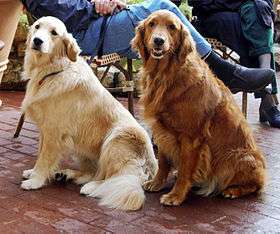Therapy dog

A therapy dog is a dog that might be trained to provide affection and comfort to people in hospitals, retirement homes, nursing homes, schools, hospices, disaster areas, and to people with autism.
Therapy dogs are usually not assistance or service dogs, but can be one or both with some organizations..
In the U.S., therapy dogs are not service animals and are not afforded the same privileges as them.[1]
History
The systematic use of therapy dogs is attributed to Elaine Smith,[2][3] who worked as a registered nurse. Smith noticed how well patients responded to visits by a chaplain and his Golden Retriever. In 1976, Smith started a program for training dogs to visit institutions, and the demand for therapy dogs continued to grow. In recent years, therapy dogs have been enlisted to help children overcome speech and emotional disorders.
Classification
Therapy dogs are usually not assistance or service dogs, but can be one or both with some organizations. Therapy dogs are not trained to assist specific individuals and do not qualify as service dogs under the Americans with Disabilities Act.[4] Institutions may invite, limit, or prohibit access by therapy dogs. If allowed, many institutions have rigorous requirements for therapy dogs. United States-based Therapy Dogs International (TDI) bans the use of service dogs in their therapy dog program.[5][6] Service dogs perform tasks for persons with disabilities and have a legal right to accompany their owners in most areas.[7] In the United States, service dogs are legally protected at the federal level by the Americans with Disabilities Act of 1990.
Many organizations provide evaluation and registration for therapy dogs. In the United States, some organizations require that a dog pass the equivalent of the American Kennel Club's Canine Good Citizen test and then add further requirements specific to the environments in which the dogs will be working. Other organizations have their own testing requirements. Typical tests might ensure that a dog can handle sudden loud or strange noises; can walk on assorted unfamiliar surfaces comfortably; are not frightened by people with canes, wheelchairs, or unusual styles of walking or moving; get along well with children and with the elderly; and so on.
In Canada, St John Ambulance provides therapy dog certification.
In the UK Pets As Therapy (PAT) provides visiting dogs and cats to establishments where pets are otherwise not available.
At colleges and universities

Some colleges and universities in the US bring therapy dogs to campus to help students de-stress. These campus events are often referred to as "Therapy Fluffies", a term coined by Torrey Trust, the original founder of the UC San Diego therapy dog de-stress event.[8] In 2009, Sharon Franks, shared the idea of bringing therapy dogs to campus with the UC San Diego Office of Student Wellness.[9] Similar events have been held worldwide.
Since the autumn of 2010, “Therapy Fluffies” has visited the UC Davis, UC Santa Cruz, and UC Riverside campuses during the week before mid-term and final exams.[10][11][12] These events give students and staff the opportunity to pet and relax with therapy-certified dogs.[13] The university also works with the Inland Empire Pet Partners, a service of the Humane Society, to bring therapy-certified dogs to the campus’ Mental Health Day Spa, held quarterly.[14][15]
In 2014, Concordia University, Wisconsin became the first university in the US to adopt a full-time therapy dog to its campus in Mequon, WI. The golden retriever, Zoey, is a Lutheran church Charities K-9 Comfort Dog, trained to interact with people at churches, schools, nursing homes, hospitals, events, and in disaster response situations.[16]
See also
| Wikimedia Commons has media related to Therapy dogs. |
References
- ↑ https://adata.org/publication/service-animals-booklet
- ↑ http://www.tdi-dog.org/About.aspx?Page=Mission+Statement+and+History
- ↑ http://www.oes.org/page2/37268~Founder_of_therapy_dogs_in_the_US_died.html
- ↑ "Information Resource on Assistance Animals for the Disabled". Nal.usda.gov. 2011-09-19. Archived from the original on 2012-04-23. Retrieved 2012-04-28.
- ↑ http://www.tdi-dog.org/HowToJoin.aspx?Page=Testing+Requirements
- ↑ http://www.ada.gov/service_animals_2010.htm
- ↑ Revised ADA Requirements: Service Animals. (2011). Retrieved July 23, 2013, from http://www.ada.gov/service_animals_2010.pdf
- ↑ "Therapy Fluffies at UCSD". 2015. Retrieved 2015-12-11.]
- ↑ "San Diego Colleges Use Dogs To Take Bite Out Of Exam Stress". 2015. Retrieved 2015-12-11.
- ↑ "Therapy Fluffies at UC Davis" (PDF). Retrieved 22 March 2015.
- ↑ Keckeisen, K. "RIVERSIDE: Therapy dogs help UCR students relieve stress". The Press Enterprise. Retrieved March 22, 2015.
- ↑ "UC Davis "Therapy Fluffies" welcomed on campus". Retrieved March 22, 2015.
- ↑ "The mind spa". Retrieved 22 March 2015.
- ↑ Lane, K. "Therapy dogs provide relief to stressed out students". Retrieved March 22, 2015.
- ↑ "Students at UC Riverside get some pet therapy as they cram for exams". Retrieved March 22, 2015.
- ↑ McCarthy, C. "K-9 comfort dog drives on CUW's campus". cuw.edu. Concordia University Wisconsin. Archived from the original on March 31, 2014. Retrieved May 28, 2014.
External links
- Assistance Animal State Laws - Michigan State University
- Disabilities and Medical Conditions - TSA (Transport Security Administration)
- National Geographic News article
- Development & Validation of a Research Instrument to Assess the Effectiveness of Animal-Assisted Therapy